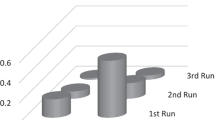Summary
In wild colonies ofBombus agrorum andB. hortorum initiation of the incipient brood clump preceded that of the honey-pot. In these, and other species, actual wax egg cells were not constructed but characteristic waxcovered brood clumps, containing eggs and pollen, were produced. Eggs of the first brood batch in natural colonies ofB. agrorum, B. humilis, B. pratorum andB. hortorum were deposited vertically.B. hortorum queens laid their eggs within the pollen lump, but inB. agrorum, B. humilis andB. pratorum, eggs were deposited against the pollen lump. In laboratory-initiated colonies, eggs were laid horizontally, often in actual wax egg cells. The order of colony initiation by captive queens did not always conform to that observed for the same species in the wild. In naturalB. agrorum andB. humilis colonies the arrangement of 8 eggs, larvae or pupae into a central row of 2 individuals, and two lateral rows of 3 individuals each, was typical.B. hortorum was more prolific, there usually being from 11 to 16 individuals in a brood clump, but no definite arrangement of eggs, larvae or pupae within brood clumps of this species was established. High brood mortality rates were not characteristic of the incipient stages of colony development in any species.
Zusammenfassung
In natürlichen Kolonien vonBombus agrorum undB. hortorum ging der Bau des ersten Brutklumpens dem des Honignapfes voraus. In diesen, und anderen Arten, wurden keine richtigen Waschseizellen gebaut, aber es wurden charakteristische wachsbedeckte Brutklumpen, welche die Eier und den Pollen enthalten, angelegt. In natürlichen Kolonien vonB. agrorum, B. humilis, B. pratorum undB. hortorum wurden die Eier des ersten Brutklumpens in vertikaler Position gelegt.B. hortorum Königinnen legten ihre Eier in den Pollenklumpen, während inB. agrorum, B. humilis undB. pratorum die Eier dem Pollenklumpen angelegt wurden. In laborgezüchteten Kolonien wurden die Eier horizontal und oft in richtige Wachseizellen gelegt. Die Reihenfolge der Nestanlage in gefangengehaltenen Königinnen entsprach nicht immer den Beobachtungen an Kolonien derselben Arten in der Natur. NatürlicheB. agrorum undB. humilis Kolonien hatten eine typische Anordnung von 8 Eiern. Larven oder Puppen in eine mittlere Reihe von 2, und zwei seitliche Reihen von je 3 Individuen.B. hortorum war produktiver, gewöhnlich mit 11–16 Individuen in einem Klumpen, aber es konnte keine bestimmte Anordnung der Eier, Larven oder Puppen innerhalb des Brutklumpens festgelegt werden. Keine der Arten wies eine hone Sterblichkeitsrate in der Entwicklung der ersten Brut auf.
Similar content being viewed by others
References
Alford (D. V.), 1970. — The production of adults in incipient colonies ofBombus agrorum (F.) (Hymenoptera: Bombidae).Proc. R. ent. Soc. Lond. (A) 45, (in press).
Brian (A. D.), 1951. — Brood development inBombus agrorum (Hym. Bombidae).Ent. mon. Mag.,87, p. 207–212.
Cumber (R. A.), 1949. — The biology of humblebees with special reference to the production of the worker caste.Trans. R. ent. Soc. Lond.,100, p. 1–45.
Free (J B.) andButler (C. G.), 1959. —Bumblebees. Collins, London.
Frison (T. H.), 1929. — A contribution to the knowledge of the bionomics ofBombus impatiens (Cresson) (Hym.).Bull. Brooklyn ent. Soc.,24, p. 261–285.
Hobbs (G. A.), 1964a. — Ecology of species ofBombus Latr. (Hymenoptera: Apidae) in southern Alberta. I. SubgenusAlpinobombus Skov.Can. Ent.,96, p. 1465–1470.—Hobbs (G. A.), 1964b. —Phylogeny of bumble bees based on brood-rearing behaviour.Can. Ent.,96, p. 115–116.—Hobbs (G. A.), 1965a. Ecology of species ofBombus Latr. (Hymenoptera: Apidae) in southern Alberta. II. SubgenusBombias Robt.Can. Ent.,97, p. 120–128.—Hobbs (G. A.), 1965b. Ecology of species ofBombus Latr. (Hymenoptera: Apidae) in southern Alberta. III. SubgenusCullumanobombus Vogt.Can. Ent.,97, p. 1293–1302.—Hobbs (G. A.) 1966a. Ecology of species ofBombus Latr. (Hymenoptera: Apidae) in southern Alberta. IV. SubgenusFervidobombus Skov.Can. Ent.,98, p. 33–39.—Hobbs (G. A.), 1966b. Ecology of species ofBombus Latr. (Hymenoptera: Apidae) in southern Alberta. V. SubgenusSubterraneobombus Vogt.Can. Ent.,98, p. 288–294.—Hobbs (G. A.), 1967. Ecology of species ofBombus (Hymenoptera: Apidae) in southern Alberta. VI. SubgenusPyrobombus. Can. Ent.,99, p. 1271–1292.—Hobbs (G. A.) 1968. Ecology of species ofBombus (Hymenoptera: Apidae) in southern Alberta. VII. SubgenusBombus. Can. Ent.,100, p. 156–164.
Jordan (R.), 1936. — Beobachtungen der Arbeitsteilung im Hummelstaate (B. muscorum).Arch. Bienenk.,17, p. 81–91.
Michener (C. D.), andMichener (M. H.), 1951. —American social insects. Van Nostrand, New York.
Plath (O. E.), 1934. —Bumblebees and their ways. MacMillan, New York.
Putnam (F. W.), 1864. — Notes on the habits of some species of humble bees.Proc. Essex Inst. Salem. Mass.,4, p. 98–105.
Rau (P.), 1941. — A note on the oviposition by the queen bumblebeeBombus americanorum.Can. Ent.,73, 55–56.
Richards (O. W.), 1953. —The social insects. MacDonald, London.
Sladen (F. W. L.), 1912. —The humble-bee its life history and how to domesticate it. MacMillan, London.
Author information
Authors and Affiliations
Rights and permissions
About this article
Cite this article
Alford, D.V. The incipient stages of development of bumblebee colonies. Ins. Soc 17, 1–10 (1970). https://doi.org/10.1007/BF02223768
Issue Date:
DOI: https://doi.org/10.1007/BF02223768




